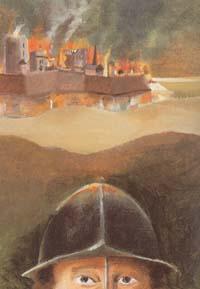|
The Curse of Cromwell

On I5 August 1649
Oliver Cromwell landed at Ringsend, near Dublin, with an army of 3,000
battle-hardened Ironsides. The civil war in England had ended, and King Charles
I had been executed seven months earlier. In Ireland, however, the Roman
Catholics had been in revolt since 1641 and held much of the island. They had
generally taken the King's side, though some had seen in England's turmoil a
chance to restore Irish independence. Cromwell entered Dublin as "lord
lieutenant and general for the parliament of England". A fanatical Protestant,
he intended to offer no quarter to papist rebels who had massacred English and
Scottish settlers. In Ireland, he could use confiscated land to pay off debts
to his troops and to the so-called "Adventurers" who had financed the
parliamentary cause.
From Dublin Cromwell marched north to Drogheda, which was defended
by an English Catholic and royalist, Sir Arthur Aston. When his surrender
demand was ignored, Cromwell stormed the city and ordered the death of every
man in the garrison, describing this as "a righteous judgment of God upon
these barbarous wretches". The nearby garrisons of Dundalk and Trim took
flight. Having secured the route to Ulster, Cromwell turned on the
south-eastern port of
Wexford, this time slaughtering townspeople and garrison alike. Neighbouring
towns quickly submitted.
Cromwell's campaign ended with an assault on Clonmel where, after
stout resistance, the defenders withdrew by night. In May 1650 he returned to
England, leaving his son-in-law, Henry Ireton, in command. Within two years
Catholic resistance was at an end. Many Irish soldiers were allowed to seek
their fortunes in Europe. Catholic land-owners were largely dispossessed, but
some were given the option of settling on less fertile land in Connacht.
Cromwell himself had been in Ireland a mere nine months, but his brutality left
an indelible impression on the native Irish. "The curse of Cromwell on
you" became an Irish oath.
|
The rebellion of 1641 had made an equal impression on the Protestant
settlers in Ulster. The plantation of Ulster had been entrusted to three
classes of land-owner. From England and Scotland came "undertakers",
who were required to bring in their tenants. Secondly, there were
"servitors", who had served the Crown in Ireland, and who were
allowed to take Irish tenants as well as newcomers. Finally, some native Irish
were allowed to own land, if they were deemed trustworthy and agreed to adopt
English farming practices. In the event, too few immigrants were attracted to
Ireland, and the undertakers found they had to accept Irish tenants. This
intermingling of the two religious groups was to prove a dangerous cocktail.
The worsening conflict between King and parliament in England
encouraged the native Irish to seek to recapture their forfeited lands. They
were also impelled by a fear that if the Puritans triumphed
in England, the Catholic religion would be suppressed. On 23 October 1641 a
series of uprisings in Ulster spread panic among the Protestant settlers. Those
who were not killed by the rebels fled for safety into the defended towns,
where plague and starvation soon took their toll. Modem historians suggest that
first accounts of the rebellion exaggerated the number of deaths and the extent
of atrocities committed by the native Irish. Wherever the truth lies, the
rebellion created in Protestant minds a distrust of their Catholic neighbours
which has survived to modern times.

The hostilities gradually spread throughout Ireland, and
in 1642 a Catholic government was formed in Kilkenny. The rebels found an experienced
commander in Owen Roe O'Neill, nephew of Hugh O'Neill, who won a famous victory
at Benburb in 1646. However, the Catholic cause was always prone to internal
dissension, and O'Neill died before he could test his generalship against
Cromwell.
|